Dear all, First, I apologize if some parts of this posting are
somewhat redundant with what Wendel said, but I was already preparing this
posting before Wendel posted his. In the earliest known so-alled Animal
Anatolian carpets from the 14th century the corner brackets appear only
when animals (confronting birds, dragon and phoenix,….) were represented
into octagonal panels. In this case the corner brackets appear only as
simple symmetric triangles, framed by hooks, filling the corners of the
panels containing the animals. The best known examples are the Marby
carpet, the Cairo (Fostat) dragon and phoenix rug in the Orient Stars
collection (plate 186), and the dragon and phoenix rug from the Islamische
Museum in Berlin. Similar rugs can be seen in paintings such as the
Spedale della Scala in Sienna in a fresco from Domenico di Bartolo dated
around 1440. It’s interesting to notice that in those "animal" rugs not
any "animate" forms can be seen in the corner brackets. I have collected
in this picture the corner brackets from the above cited animal rugs. 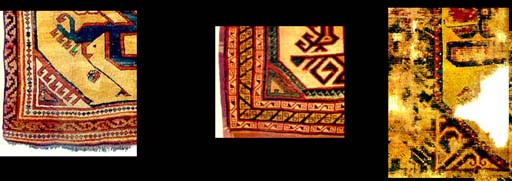 During the 15th century, maybe
because more pieces are available, the corner brackets, which were widely
used in Anatolian rugs, appear in a lot of various forms as well in
workshop products such as the so called "Holbein" rugs as in village rugs.
The drawing of the corner brackets is very simple or complex, symmetric or
not. Small dotted triangle framed by hooks devices pointing inside or
outside, or more complex Kufic forms, floral forms …. I don’t see any rug
design evolution, design tradition, or animate forms in the drawing of the
spandrels. The drawing of the corner brackets isn’t specific of any rug
products in Anatolia. The same corner brackets appear all along the
centuries in various shape in village rugs or in so called Holbein rugs,
keyhole Bellini rugs or Crivelli star rugs, to cite the best known type of
the 15th century. I have collected in this picture the corner brackets
from the above cited 15th century rugs. During the 15th century, maybe
because more pieces are available, the corner brackets, which were widely
used in Anatolian rugs, appear in a lot of various forms as well in
workshop products such as the so called "Holbein" rugs as in village rugs.
The drawing of the corner brackets is very simple or complex, symmetric or
not. Small dotted triangle framed by hooks devices pointing inside or
outside, or more complex Kufic forms, floral forms …. I don’t see any rug
design evolution, design tradition, or animate forms in the drawing of the
spandrels. The drawing of the corner brackets isn’t specific of any rug
products in Anatolia. The same corner brackets appear all along the
centuries in various shape in village rugs or in so called Holbein rugs,
keyhole Bellini rugs or Crivelli star rugs, to cite the best known type of
the 15th century. I have collected in this picture the corner brackets
from the above cited 15th century rugs. 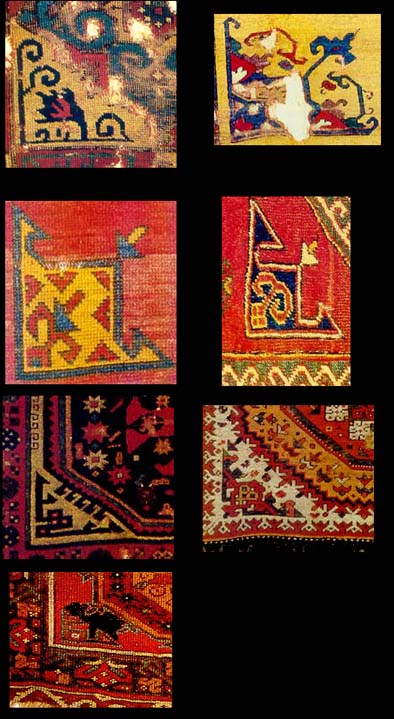 (Close-up from Orient Stars
plate 196,189,190 and from Le Tapis Chrétien Oriental ill. 254 TIEM N° 701
ill. 259 BOIM and 260 BMIK N° 79. Even in the same rug several kinds of
corner brackets framing panels or not can be seen. In the following
picture (close-up from plate 198 in Orient Stars -16th century) the
drawing of the top and bottom corner brackets are already different. (Close-up from Orient Stars
plate 196,189,190 and from Le Tapis Chrétien Oriental ill. 254 TIEM N° 701
ill. 259 BOIM and 260 BMIK N° 79. Even in the same rug several kinds of
corner brackets framing panels or not can be seen. In the following
picture (close-up from plate 198 in Orient Stars -16th century) the
drawing of the top and bottom corner brackets are already different. 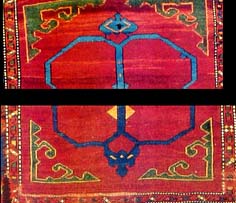 In the following picture (close-up
from plate 198 in Orient Stars -15th century) at least two different type
of corner brackets are used in the same rug In the following picture (close-up
from plate 198 in Orient Stars -15th century) at least two different type
of corner brackets are used in the same rug  And it appears really clearly in
this closeup from a Crivelli star rug (ill.352: from Le Tapis Chrétien
Oriental) And it appears really clearly in
this closeup from a Crivelli star rug (ill.352: from Le Tapis Chrétien
Oriental) 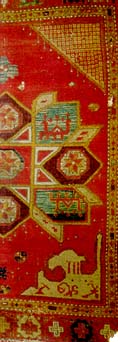 The corner
brackets stayed almost simple and symmetrical when they framed geometric
panels, and more complex asymmetrical forms appear only when they were
"disconnected". If we look carefully to the asymmetrical corner brackets,
it’s almost their vertical bracket which are longer. They follow the shape
of the rug to conserve a balance in the design. Another reason is that
there wasn’t enough place to draw symmetrically the horizontal and
vertical bracket. This can be clearly seen when medallions with pendants
were used. In this case the weaver often needed to reduce the horizontal
bracket because of the place occupied by the pendant. This can be clearly
seen in the following picture where I have collected the corner brackets
coming from plates 131, 132, 204, 205 in Orient Stars. The corner
brackets stayed almost simple and symmetrical when they framed geometric
panels, and more complex asymmetrical forms appear only when they were
"disconnected". If we look carefully to the asymmetrical corner brackets,
it’s almost their vertical bracket which are longer. They follow the shape
of the rug to conserve a balance in the design. Another reason is that
there wasn’t enough place to draw symmetrically the horizontal and
vertical bracket. This can be clearly seen when medallions with pendants
were used. In this case the weaver often needed to reduce the horizontal
bracket because of the place occupied by the pendant. This can be clearly
seen in the following picture where I have collected the corner brackets
coming from plates 131, 132, 204, 205 in Orient Stars. 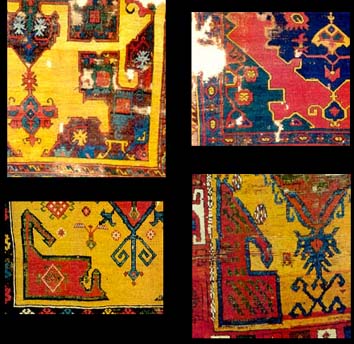 Commenting the spandrels of plate
203 in Orient Stars, a "small pattern Holbein" prototype from the 15th
century, Commenting the spandrels of plate
203 in Orient Stars, a "small pattern Holbein" prototype from the 15th
century, 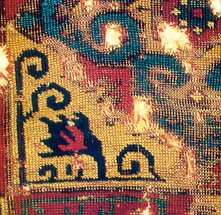 Heinrich Kirscheim
says: "Why did the weaver choose to knot-in the complex serrations on the
long sides of these spandrels? No doubt because it was vital as faithful
as possible a representation of this design element – the pregnant human
female, seen in section….the upper part is pointed, to form the head of
the woman; her swollen belly contains a red fetus shape, and the vertical
blue line ending in two curls represents her feets…" May be you will see
it …… I don’t. Cordially, Daniel Heinrich Kirscheim
says: "Why did the weaver choose to knot-in the complex serrations on the
long sides of these spandrels? No doubt because it was vital as faithful
as possible a representation of this design element – the pregnant human
female, seen in section….the upper part is pointed, to form the head of
the woman; her swollen belly contains a red fetus shape, and the vertical
blue line ending in two curls represents her feets…" May be you will see
it …… I don’t. Cordially, Daniel |
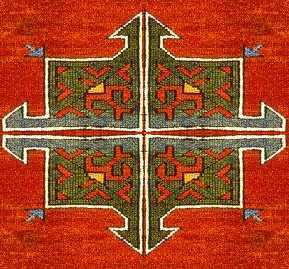 I'm not sure of which border design you speak (my English...)
but I guess that both of your explanations maybe could be the same because
many border elements, if mirrored, turn into ornaments which we are more
familiar to see. Or said the other way round, many border designs seem to
be construed of parts of actual ornaments, just as the corner brackets.
I'm not sure of which border design you speak (my English...)
but I guess that both of your explanations maybe could be the same because
many border elements, if mirrored, turn into ornaments which we are more
familiar to see. Or said the other way round, many border designs seem to
be construed of parts of actual ornaments, just as the corner brackets.
 Apropos border designs, could
the similarity between the Mihrab of the Seljuk prayer rug and the border
found on some early Turkish carpets be more than coincidence?
Apropos border designs, could
the similarity between the Mihrab of the Seljuk prayer rug and the border
found on some early Turkish carpets be more than coincidence? 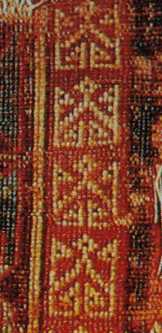 And am I wrong or tend the border
design elements of earlier (Turkish) carpets to be less symmetric (having
less mirror axes) then later ones? Regards, Christoph
And am I wrong or tend the border
design elements of earlier (Turkish) carpets to be less symmetric (having
less mirror axes) then later ones? Regards, Christoph During the 15th century, maybe
because more pieces are available, the corner brackets, which were widely
used in Anatolian rugs, appear in a lot of various forms as well in
workshop products such as the so called "Holbein" rugs as in village rugs.
The drawing of the corner brackets is very simple or complex, symmetric or
not. Small dotted triangle framed by hooks devices pointing inside or
outside, or more complex Kufic forms, floral forms …. I don’t see any rug
design evolution, design tradition, or animate forms in the drawing of the
spandrels. The drawing of the corner brackets isn’t specific of any rug
products in Anatolia. The same corner brackets appear all along the
centuries in various shape in village rugs or in so called Holbein rugs,
keyhole Bellini rugs or Crivelli star rugs, to cite the best known type of
the 15th century. I have collected in this picture the corner brackets
from the above cited 15th century rugs.
During the 15th century, maybe
because more pieces are available, the corner brackets, which were widely
used in Anatolian rugs, appear in a lot of various forms as well in
workshop products such as the so called "Holbein" rugs as in village rugs.
The drawing of the corner brackets is very simple or complex, symmetric or
not. Small dotted triangle framed by hooks devices pointing inside or
outside, or more complex Kufic forms, floral forms …. I don’t see any rug
design evolution, design tradition, or animate forms in the drawing of the
spandrels. The drawing of the corner brackets isn’t specific of any rug
products in Anatolia. The same corner brackets appear all along the
centuries in various shape in village rugs or in so called Holbein rugs,
keyhole Bellini rugs or Crivelli star rugs, to cite the best known type of
the 15th century. I have collected in this picture the corner brackets
from the above cited 15th century rugs.  (Close-up from Orient Stars
plate 196,189,190 and from Le Tapis Chrétien Oriental ill. 254 TIEM N° 701
ill. 259 BOIM and 260 BMIK N° 79. Even in the same rug several kinds of
corner brackets framing panels or not can be seen. In the following
picture (close-up from plate 198 in Orient Stars -16th century) the
drawing of the top and bottom corner brackets are already different.
(Close-up from Orient Stars
plate 196,189,190 and from Le Tapis Chrétien Oriental ill. 254 TIEM N° 701
ill. 259 BOIM and 260 BMIK N° 79. Even in the same rug several kinds of
corner brackets framing panels or not can be seen. In the following
picture (close-up from plate 198 in Orient Stars -16th century) the
drawing of the top and bottom corner brackets are already different.  In the following picture (close-up
from plate 198 in Orient Stars -15th century) at least two different type
of corner brackets are used in the same rug
In the following picture (close-up
from plate 198 in Orient Stars -15th century) at least two different type
of corner brackets are used in the same rug  And it appears really clearly in
this closeup from a Crivelli star rug (ill.352: from Le Tapis Chrétien
Oriental)
And it appears really clearly in
this closeup from a Crivelli star rug (ill.352: from Le Tapis Chrétien
Oriental)  The corner
brackets stayed almost simple and symmetrical when they framed geometric
panels, and more complex asymmetrical forms appear only when they were
"disconnected". If we look carefully to the asymmetrical corner brackets,
it’s almost their vertical bracket which are longer. They follow the shape
of the rug to conserve a balance in the design. Another reason is that
there wasn’t enough place to draw symmetrically the horizontal and
vertical bracket. This can be clearly seen when medallions with pendants
were used. In this case the weaver often needed to reduce the horizontal
bracket because of the place occupied by the pendant. This can be clearly
seen in the following picture where I have collected the corner brackets
coming from plates 131, 132, 204, 205 in Orient Stars.
The corner
brackets stayed almost simple and symmetrical when they framed geometric
panels, and more complex asymmetrical forms appear only when they were
"disconnected". If we look carefully to the asymmetrical corner brackets,
it’s almost their vertical bracket which are longer. They follow the shape
of the rug to conserve a balance in the design. Another reason is that
there wasn’t enough place to draw symmetrically the horizontal and
vertical bracket. This can be clearly seen when medallions with pendants
were used. In this case the weaver often needed to reduce the horizontal
bracket because of the place occupied by the pendant. This can be clearly
seen in the following picture where I have collected the corner brackets
coming from plates 131, 132, 204, 205 in Orient Stars.  Commenting the spandrels of plate
203 in Orient Stars, a "small pattern Holbein" prototype from the 15th
century,
Commenting the spandrels of plate
203 in Orient Stars, a "small pattern Holbein" prototype from the 15th
century,  Heinrich Kirscheim
says: "Why did the weaver choose to knot-in the complex serrations on the
long sides of these spandrels? No doubt because it was vital as faithful
as possible a representation of this design element – the pregnant human
female, seen in section….the upper part is pointed, to form the head of
the woman; her swollen belly contains a red fetus shape, and the vertical
blue line ending in two curls represents her feets…" May be you will see
it …… I don’t. Cordially, Daniel
Heinrich Kirscheim
says: "Why did the weaver choose to knot-in the complex serrations on the
long sides of these spandrels? No doubt because it was vital as faithful
as possible a representation of this design element – the pregnant human
female, seen in section….the upper part is pointed, to form the head of
the woman; her swollen belly contains a red fetus shape, and the vertical
blue line ending in two curls represents her feets…" May be you will see
it …… I don’t. Cordially, Daniel